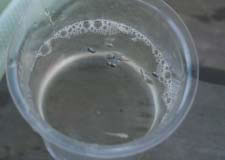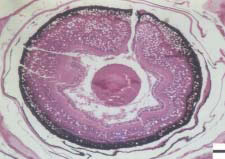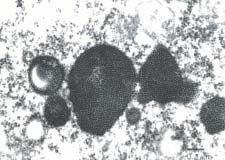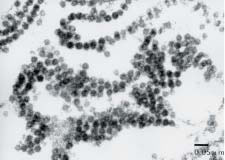Mass mortalities associated with viral nervous necrosis in hatchery-reared orange-spotted grouper in the Philippines
Description
[Objectives]
In 2001, severe acute mortality characterized by anorexia and abnormal swimming behavior was observed among hatchery-reared larvae of the orange-spotted grouper Epinephelus coioides in the Philippines. Mortality rates of 5 to 10 percent per day were observed with 100 percent morality being reached within 10 days. A viral etiological study on this mass mortality was conducted using histopathological techniques, cell culture utilizing SSN-1 cell lines (established cells derived from striped snakehead whole fry), reverse transcription-PCR (RTPCR) and electron microscopy.
[Results]
The initial clinical signs of affected larvae were reduced feeding activity followed by darkening pigmentation. Diseased fish became lethargic, often lying with their abdomen-up and rising to the surface of water. Abnormal swimming behaviors, such as rotating, spinning, and horizontal looping were observed (Fig. 1). Histopathological examination by light microscopy revealed heavy vacuolation in the brain and retina (Fig. 2). Cytopathic effects were observed in SSN-1 cells two days after inoculation with the filtrate of the affected grouper characterized by cytoplasmic vacuole formation. By PCR technique using primers based on the sequence of the striped jack nervous necrosis virus RNA 2 gene, an amplified product of about 430 base pairs was observed in samples from naturally infected fish and the culture supernatant of SSN-1 cells inoculated with the tissue filtrate of affected fish. The size of the PCR product was consistent with that of other piscine nodaviruses using the same primer set. Small spherical, non-enveloped virus particles 20-25 nm in diameter arranged in paracrystalline arrays or in membrane-bounded vesicles were abundantly observed in the cytoplasm of the brain (Fig. 3) and retina.
The histopathological lesions and other clinical signs observed in moribund orange-spotted grouper were very similar to those described in other viral nervous necrosis (VNN)-affected fish species. The isolated virus was identified as a piscine nodavirus based on the results of RT-PCR and electron microscopy performed on infected cell cultures. Furthermore, the experimental infection trial reproduced the same clinical signs and the virus was re-isolated from the experimentally infected fish (Fig. 4). These results clearly indicate that the mass mortality of the larval grouper was caused by VNN. This is the first documented outbreak of VNN among hatchery-reared larvae of orange-spotted grouper in the Philippines.
The present study was carried out as part of international research project "Studies on sustainable production systems of aquatic animals in brackish mangrove areas" between JIRCAS and South East Asian Fisheries Development Center, Aquaculture Department (SEAFDEC AQD).
Figure, table
-
Fig. 1. Orange spotted grouper larvae affected with viral nervous necrosis (VNN). -
Fig. 2. Light micrograph showing vacuolation in the retina of affected orange-spotted grouper larvae. Haematoxylin and eosin staining. Scale bar = 100μm. -
Fig. 3. Electron micrograph of virus particles in the brain cytoplasm of affected orange-spotted grouper. Scale bar = 200 nm. -
Fig. 4. Electron micrograph of virus particles in the brain cytoplasm of experimentally infected orange-spotted grouper. Scale bar = 50 nm.
- Affiliation
-
Japan International Research Center for Agricultural Sciences Fisheries Division
- Classification
-
Technical A
- Term of research
-
FY2002 (FY2000-2005)
- Responsible researcher
-
MAENO Yukio ( Fisheries Division )
DELAPEÑA Leobert D. ( Southeast Asian Fisheries Development Center )
CRUZ-LACIERDA Erlinda R. ( Southeast Asian Fisheries Development Center )
- ほか
- Publication, etc.
-
Maeno, Y., de la Pena, L. D. and Cruz-Lacierda, E. R. (2002): Nodavirus infection in hatchery-reared orangespotted grouper Epinephelus coioides: First record of viral nervous necrosis in the Philippines. Fish Pathology, 37, 87-89.
Maeno, Y., de la Pena, L. D. and Cruz-Lacierda, E. R. (2003): Mass mortalities associated with viral nervous necrosis in hatchery-reared sea bass, Lates calcarifer in the Philippines. JARQ.
Lio-Po, G. D., Cruz-Lacierda, E. R., de la Pena, L. D., Maeno, Y. and Inui, Y. (2002): Progress and current status of diagnostic techniques for marine fish viral diseases at the SEAFDEC Aquaculture Department. In Disease control in fish and shrimp aquaculture in Southeast Asia-diagnosis and husbandry techniques. eds. Inui, Y and Cruz-Lacierda, E. R., SEAFDEC, Iloilo, Philippines, 97-106.
- Japanese PDF
-
2002_22_A3_ja.pdf917.44 KB
- English PDF
-
2002_22_A4_en.pdf73.83 KB




